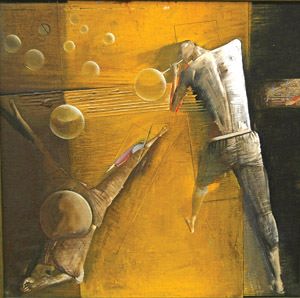Unofficial colors and images
Ukrainian 20th century underground art is only just making itself known
The Ukrainian underground requires understanding and interpretation. The complexity and diversity of the styles used by painters in this trend of contemporary art, and even the differences in the artists’ personal, social, and political positions, have not yet received a definite assessment on the part of experts and critics. Thence the cacophony of opinions when it comes to defining and classifying the artistic heritage left by the Ukrainian underground.
The concept of underground tends to be associated with “informal art.” However, there is also a different perspective. Some art critics believe it to be a different trend in art, with both kinds being the manifestations of a broader phenomenon — nonconformism.
However, while the underground represents the most radical artistic forms of resistance to totalitarianism (it is here that one finds works having social and political coloring, whose authors were persecuted or prohibited by the regime), informal art is more moderate in its essence.
This month, the National Art Museum is holding an exhibit entitled “Colors and Images of 20th Century Ukrainian Art,” dedicated to the works of Ukrainian painters of the 1960s through the 1990s. The presented works help visitors realize the differences between the nuances and moods in the artists from different trends.
The Ukrainian underground is informal art, represented at the exhibit by the artistic milieux of Odesa, Lviv, and Kyiv. These milieux differ from each other considerably. No wonder, as the level of social and political life, and the degree of exposure to information from the West, was different in each of these cities.
For instance, Lviv, where the modernist tradition lasted throughout the Soviet times, is represented by the mature works of Liubomyr Medvid and Mykola Shymchuk. The works by Kyiv artists Yakym Levych, Oleksandr Dubovyk, and Valerii Lamakh show that for them, the intellectual constituent of the painting was the key factor. The art from Odessa is exemplified by Liudmyla Yastreb, Viktor Maryniuk, and Viktor Strelnikov.
At the same time experts single out several other trends in the Ukrainian art of the Soviet period. So-called legal art can be seen in the 1970s-80s. The works by “legal” artists Viktor Ryzhykh, Halyna Neledva, Halyna Hryhorieva, Yurii Lutskevych, and Zoia Lierman appealed to popular tradition, to international classical art, and Ukrainian baroque. “Legal” artists were sometimes even allowed to participate in official exhibits — in the more remote rooms.
Another dimension of the Ukrainian art of those times is “quiet painting,” represented in the exhibit by Olena Yablonska’s, Borys Rapoport’s, and Olha Otroshchenko’s works. These artists tended to avoid social and political themes and preferred landscapes and still nature, executed outside the canons of academic painting, yet without appealing to burning social issues.
Photoreproductions by Kostiantyn HRYSHYN, The Day, made at the exhibit “Colors and Images of 20th Century Ukrainian Art,” at the National Art Museum of Ukraine






